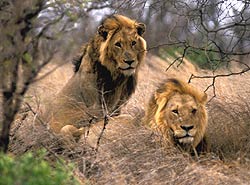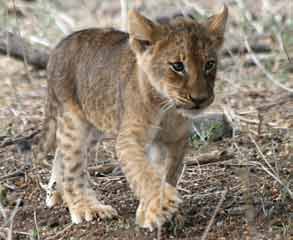Lion Information

|
Quick Lion Facts
Family: Felidae (Cats)
Scientific name: Panthera leo
Average shoulder height: Males - 1.2 m;
Females - 90 cm.
Weight: Males - 190 kg; Females - 130 kg.
Gestation period: 110 days
Life expectancy: 13 -15 yrs
|

Lion cub, showing faint spots on the lower parts
Appearance
The lion, tawny to sandy brown in colour, is the largest
of the African carnivores. Cubs are faintly spotted on
the lower parts; some adults retain traces of the spots.
Adult males have manes that vary in colour from tawny to
black. This, together with their larger size,
distinguishes them from females.
Behavior
Lions live a lazy lifestyle, typically active for only
two to four hours in every 24. They are most active at
night and rest during the day. A lion pride
consists of a group of two to 12 closely related adult females with their young,
attended by one to six adult males. If there is more than
one male they are often, but not always, close relatives,
often brothers.
Only pride males have access to the pride
females. Males take over prides by driving out the
current males in savage and sometimes fatal fights, and
are in turn displaced by new challengers after one to 10
years. The new males expel any young males from the pride
and try to kill all the cubs to bring the females quickly
back into breeding condition and so ensure offspring will
have their genes.
After a take-over females come into heat and
mate but, amazingly, do not bear cubs until the new males
have established their status against possible
challengers.
Reproduction
Females give birth to litters of up to six cubs (usually
one to four). Weaning starts at 10
weeks, and is completed by six months. Lions mate about
four times an hour over two to three days! Pride males do
not compete for available females as these females will
mate with all of a pride's males in turn as each loses
interest in her. Pride females suckle one another's cubs,
with no bias towards their own.
Hunting
Lions differ from other cats by regularly hunting in
groups. When hunting small prey, each lion pursues its
own animal; with larger and more dangerous prey
co-operation is needed to split a herd or pull down and
kill one animal.
Most of the hunting is done by the females. When
in a pride, the males take what food they want from the
females. Cubs get what the adults leave, and in times of
food shortage, starvation is their major cause of
death.
Diet
Medium and large prey, including impala, wildebeest,
zebra and gemsbok. Will also take larger species such as
buffalo, giraffe, hippo and young elephants. Lions will
also eats birds, reptiles, fish, and even insects, also
smaller mammals down to the size of mice.
Sounds
To hear the roar of lions at night is an experience to be
savoured - provided you're safely in your tent or
bungalow. Typically a lion's roar will start with a
series of low grunts, building to a reverberating
crescendo before trailing off again. Lions also grunt,
cough and snarl.
For additional information about lions, see Lion Facts and Lions Mating.
Return to Wildlife Info
|


